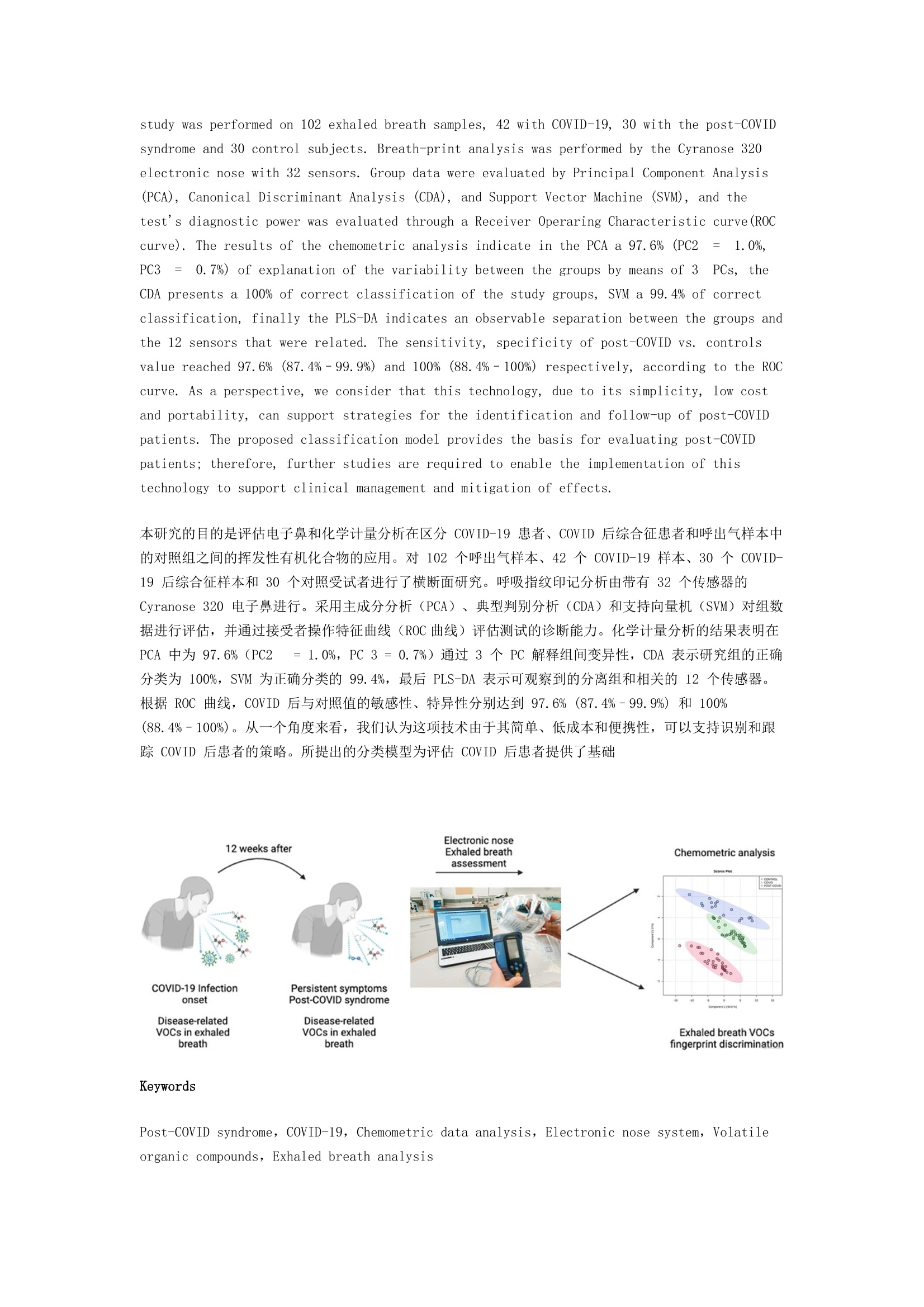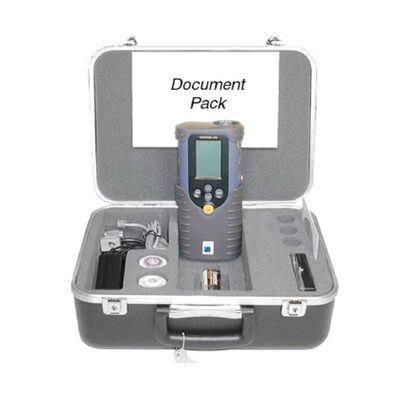COVID-19患者、COVID后和健康受试者呼出气体中挥发性有机物检测方案(感官智能分析)
检测样品 其他
检测项目 其他
方案详情文
智能文字提取功能测试中
Chemometric analysis of the global pattern of volatile organic compounds in the exhaledbreath of patients with COVID-19, post-COVID and healthy subjects. Proof of concept forpost-COVID assessment 对 COVID-19 患者、COVID后和健康受试者呼出的气体中挥发性有机化合物的整体模型进行化学计量分析. COVID 后评估的概念证明 Blanca Nohemi, Zamora-Mendoza, LorenaDiaz de Leon-Martinez, MaribelRodriguez-Aguilar,BorisMizaikoffb, RogelioFlores-Ramirez° Faculty of Medicine-Center for Applied Research on Environment and Health (CIAAS), Autonomous University of San Luis Potosi, Avenida Sierra Leona No. 550, Colonia LomasSegunda Seccion, CP, 78210, San Luis Potosi, SLP, Mexico Institute of Analytical and Bioanalytical Chemistry, Ulm University, Albert-Einstein-Allee11,89081, Ulm, Germany Hahn-Schickard Institute for Microanalysis Systems, Sedanstrasse 14, 89077, Ulm, GermanyDepartment of Pharmacy, Health Sciences Division. University of Quintana Roo, Quintana Roo,Mexico CONACYT Research Fellow, Coordination for Innovation and Application of Science and Technology (CIACYT), Autonomous University of San Luis Potosi, Avenida Sierra Leona No. 550, CP, 78210, Colonia Lomas Segunda Seccion, San Luis Potosi, SLP, Mexico Received 23 July 2021, Revised 21 August 2021, Accepted 28 August 2021, Available online 2September 2021, Version of Record 4 September 2021. Highlights Post-COVID syndrome screening is vital in the present pandemic. ·Electronic nose is capable of distinguish between VOCs fingerprints in exhaled breath. ·Discrimination between COVID-19, post-COVID and controls breath fingerprints. PCA 96.39% of explanation of the variability. ·CDA and SVM 100% and 99.4% of correct classification respectively. ·在当前的大流行中, COVID 后综合征筛查至关重要。 ·电子鼻能够区分呼出气中的 VOC 指纹。 区分 COVID-19、COVID-19 后和控制呼吸指纹。 PCA 96.39%的变异性解释。 ·CDA 和 SVM分别为100%和99.4%的正确分类。 Abstract The objective of this research was to evaluate the application of an electronic noseand chemometric analysis to discriminate volatile organic compounds between patients withCOVID-19, post-COVID syndrome and controls in exhaled breath samples. A cross-sectional study was performed on 102 exhaled breath samples, 42 with COVID-19, 30 with the post-COVIDsyndrome and 30 control subjects. Breath-print analysis was performed by the Cyranose 320electronic nose with 32 sensors. Group data were evaluated by Principal Component Analysis(PCA), Canonical Discriminant Analysis (CDA), and Support Vector Machine (SVM), and thetest's diagnostic power was evaluated through a Receiver Operaring Characteristic curve(ROCcurve). The results of the chemometric analysis indicate in the PCA a 97.6% (PC2 1. 0%,PC3 = 0.7%) of explanation of the variability between the groups by means of 3 PCs, theCDA presents a 100% of correct classification of the study groups, SVM a 99.4% of correctclassification, finally the PLS-DA indicates an observable separation between the groups andthe 12 sensors that were related. The sensitivity, specificity of post-COVID vs. controlsvalue reached 97.6%(87.4%-99.9%) and 100% (88.4%-100%) respectively, according to the ROCcurve. As a perspective, we consider that this technology, due to its simplicity, low costand portability, can support strategies for the identification and follow-up of post-COVIDpatients. The proposed classification model provides the basis for evaluating post-COVIDpatients; therefore, further studies are required to enable the implementation of thistechnology to support clinical management and mitigation of effects. 本研究的目的是评估电子鼻和化学计量分析在区分 COVID-19 患者、COVID后综合征患者和呼出气样本中的对照组之间的挥发性有机化合物的应用。对102个寸出气样本、42个 COVID-19 样本、30个 COVID-19 后综合征样本和30个对照受试者进行了横断面研究。呼吸指纹印记分析由带有32个传感器的Cyranose 320 电子鼻进行。采用主成分分析(PCA)、典型判别分析(CDA)和支持向量机(SVM)对组数据进行评估,并通过接受者操作特征曲线 (ROC曲线)评估测试的诊断能力。化学计量分析的结果表明在PCA 中为 97.6% (PC2 = 1.0%, PC 3=0.7%)通过3个PC 解释组间变异性, CDA 表示研究组的正确分类为100%, SVM 为正确分类的99.4%,最后 PLS-DA 表示可观察到的分离组和相关的12个传感器。根据 ROC 曲线, COVID 后与对照值的敏感性、特异性分别达到97.6%(87.4%-99.9%)和 100%(88.4%-100%)。从一个角度来看,我们认为这项技术由于其简单、低成本和便携性,可以支持识别和跟踪 COVID 后患者的策略。所提出的分类模型为评估 COVID 后患者提供了基础 Keywords Post-COVID syndrome, COVID-19, Chemometric data analysis, Electronic nose system, Volatileorganic compounds, Exhaled breath analysis COVID 后综合征,新冠肺炎,化学计量学数据分析,电子鼻系统,挥发性有机化合物,呼出气分析 原文链接: https://www.sciencedirect.com/science/article/pii/S0039914021007530 本研究的目的是评估电子鼻和化学计量分析在区分 COVID-19 患者、COVID 后综合征患者和呼出气样本中的对照组之间的挥发性有机化合物的应用。对 102 个呼出气样本、42 个 COVID-19 样本、30 个 COVID-19 后综合征样本和 30 个对照受试者进行了横断面研究。呼吸指纹印记分析由带有 32 个传感器的 Cyranose 320 电子鼻进行。采用主成分分析(PCA)、典型判别分析(CDA)和支持向量机(SVM)对组数据进行评估,并通过接受者操作特征曲线(ROC曲线)评估测试的诊断能力。化学计量分析的结果表明在 PCA 中为 97.6%(PC2 = 1.0%,PC 3 = 0.7%)通过 3 个 PC 解释组间变异性,CDA 表示研究组的正确分类为 100%,SVM 为正确分类的 99.4%,最后 PLS-DA 表示可观察到的分离组和相关的 12 个传感器。根据 ROC 曲线,COVID 后与对照值的敏感性、特异性分别达到 97.6% (87.4%–99.9%) 和 100% (88.4%–100%)。从一个角度来看,我们认为这项技术由于其简单、低成本和便携性,可以支持识别和跟踪 COVID 后患者的策略。所提出的分类模型为评估 COVID 后患者提供了基础
关闭-
1/3

-
2/3

还剩1页未读,是否继续阅读?
继续免费阅读全文产品配置单
图拉扬科技有限公司为您提供《COVID-19患者、COVID后和健康受试者呼出气体中挥发性有机物检测方案(感官智能分析)》,该方案主要用于其他中其他检测,参考标准《暂无》,《COVID-19患者、COVID后和健康受试者呼出气体中挥发性有机物检测方案(感官智能分析)》用到的仪器有Cyranose 320 电子鼻。
我要纠错
相关方案



 咨询
咨询






